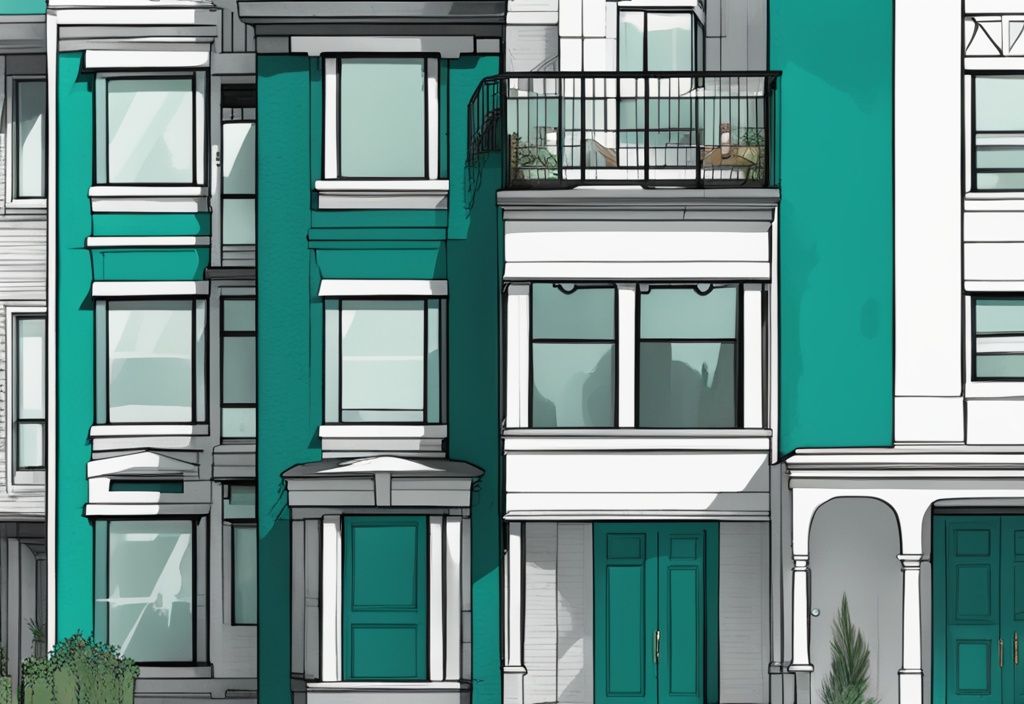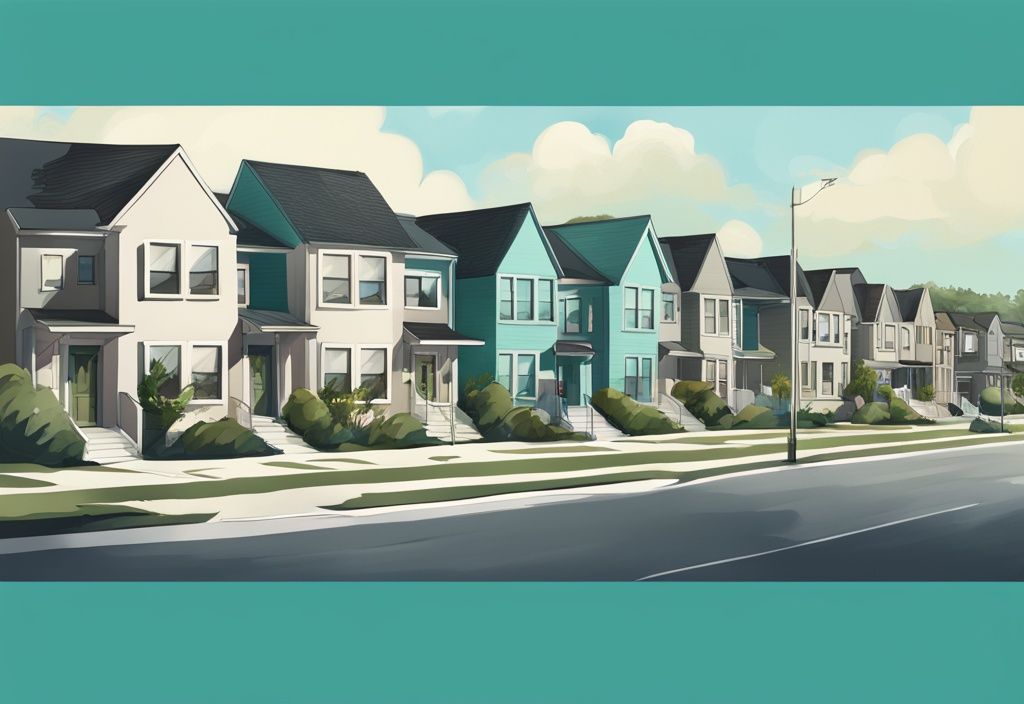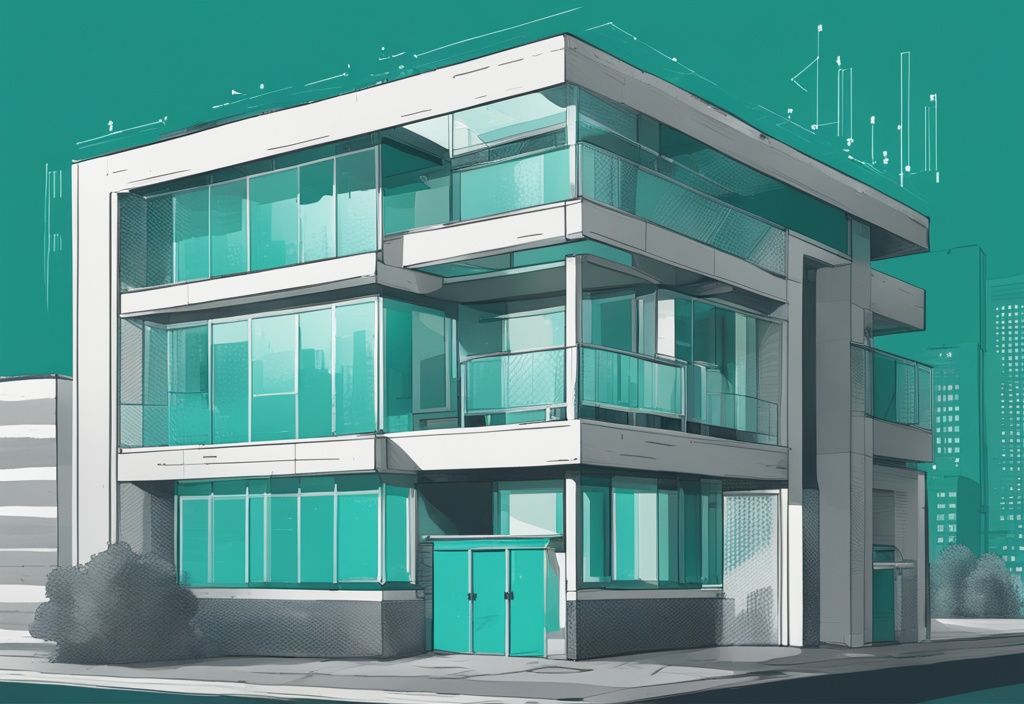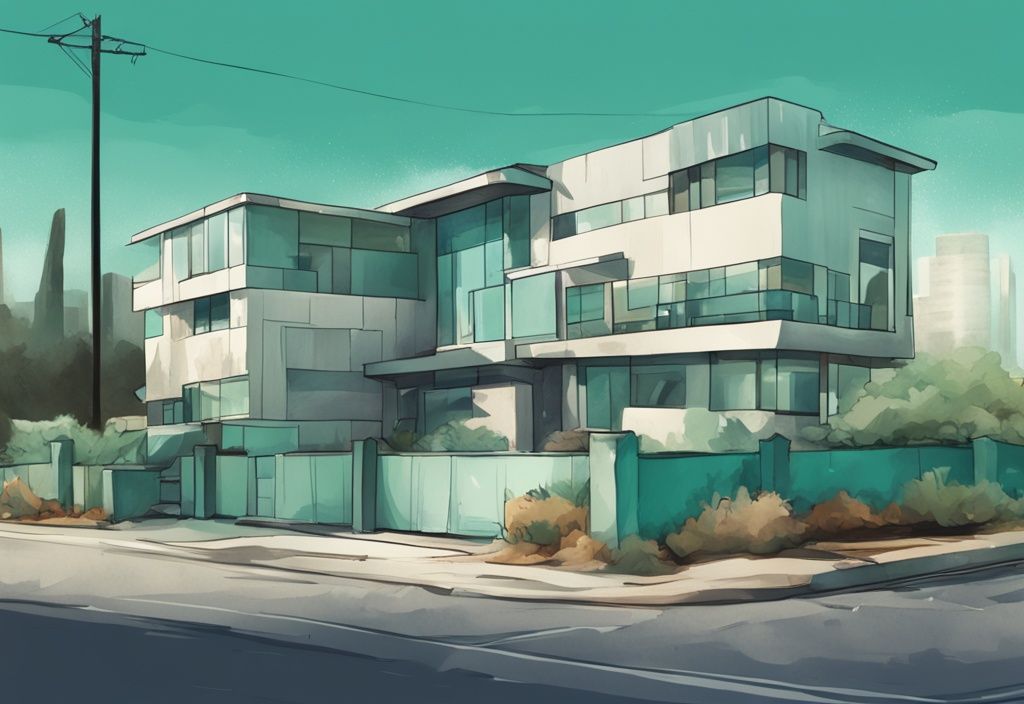Ever wondered what a party wall in real estate is? Or even more intriguingly, why it matters to you as a homeowner or potential property investor? Well, you’ve clicked on the right article. Think of a party wall as a kind-hearted mediator that creates harmony in densely populated properties, like apartments and townhouses. But there’s more to it than just being a ‘good neighbor’.
Delving into the world of party walls, you’ll discover their unique features while also unraveling the web of associated legalities. In this article, I’ll stroll you through this crucial, yet often overlooked concept, simplifying complex terminologies along the way. Remember, navigating real estate smartly calls for a solid grasp of such details.
So, ready for a crash course in party walls? Let’s uncover their intriguing world together, not just to avoid future disagreements, but to empower you with the knowledge you need to make informed decisions. After all, a good neighbor makes a great wall, right?
What is a Party Wall?
A party wall, in real estate, is a shared architectural element that marks the boundary between two distinct properties owned by different individuals. This wall not only provides a clear separation but also adds essential structural support. Whether it’s residential or commercial properties, party walls are a universal feature that plays an important role in property development.
In apartment complexes and condominium units, party walls serve as the dividing line between individual living spaces. Think of it as the backbone of high-density housing, ensuring that each residence holds its own while collectively supporting the overall stability of the building.
Townhouses and semi-detached houses also frequently feature party walls. These walls do more than just separate properties; they create sturdy, well-defined living spaces. The clear boundary allows for individual ownership but also fosters a sense of community through shared structural support.
Similarly, in terraced houses, office complexes, and hotels, party walls help delineate individual units or offices. Each unit has its own distinct ownership yet contributes to the overall structural integrity. The presence of these walls highlights their importance across diverse property types, making them a key element of urban development.
Understanding a party wall in real estate is about recognizing its dual role in separation and support. These walls not only define property boundaries but also provide necessary structural integrity, enhancing both the safety and stability of buildings.
In summary, party walls are foundational elements in various building types, such as residential apartments, townhouses, and commercial office spaces. Their role in defining property boundaries, offering structural support, and ensuring the privacy and stability of adjoining units cannot be overstated. Incorporating the concept of a party wall into property development is crucial for creating well-structured, harmonious living and working environments.
Key Features of Party Walls
Party walls play a vital role in real estate, acting as crucial elements that both support and separate adjoining properties. Let’s dive into their key features and understand more about what is a party wall in real estate.
Support and Separation
Party walls are the backbone for neighboring units, providing essential structural support to keep each property stable and enduring. Think of them as the sturdy spine in a body, keeping everything upright and in place.
Besides offering support, these walls act as a firm handshake that clearly defines where one property ends and the other begins. This distinct barrier ensures each property retains its individual charm and identity. Plus, they do wonders for privacy! With the added insulation, party walls significantly cut down on noise transfer, making sure your neighbor’s late-night TV binge-watching doesn’t disturb your sleep. Understanding what is a party wall in real estate shows us how they brilliantly juggle the dual role of supporting and separating properties.
Soundproofing and Fire Resistance
One of the standout features of party walls is their soundproofing capability. By minimizing noise transfer, these walls create a serene atmosphere inside each property. Imagine enjoying a peaceful Sunday morning coffee without the sound of your neighbor’s vacuum cleaner disrupting your calm – that’s the magic of effective soundproofing.
But the benefits don’t stop at noise reduction. Many building codes require party walls to be constructed with noncombustible materials, serving as robust firewalls, as detailed in the related code sections on party walls. This fire-resistance feature is crucial for safety, as it slows the spread of fire. In an emergency, this gives occupants more time to evacuate and can significantly reduce potential damage.

The combination of soundproofing and fire resistance encapsulates what is a party wall in real estate, highlighting their indispensable role in ensuring a safe and pleasant living environment. Whether in residential or commercial settings, these features make party walls an essential part of modern architecture.
Party Walls: Common Real Estate Properties
Apartments and Condominiums
In high-density living environments like apartments and condominiums, knowing what a party wall in real estate is can make all the difference. Picture this: you’re in your cozy apartment, enjoying some quiet time, but you’ve got neighbors on either side. This is where party walls come into play. These walls separate individual living units, giving each resident their own distinct, private space.
But that’s not all—party walls also lend crucial structural support to the entire building. Ever noticed how you hardly hear what’s happening next door? That’s because these walls are designed to reduce noise transfer effectively. They’re typically built from noncombustible materials, ensuring compliance with fire safety standards and enhancing the security for everyone in the building. It’s like each unit gets its own slice of peace and quiet, wrapped in a security blanket.
Townhouses and Semi-Detached Houses
In the world of townhouses and semi-detached houses, party walls serve as vital components for both property boundaries and structural integrity. Imagine two homes standing side by side, sharing one or more common walls. These are the party walls that create a clear demarcation between properties, allowing each homeowner to enjoy their individual space to the fullest.
One of the great things about party walls in low-density settings is they offer shared structural support, keeping both homes securely supported. Think of it like two friends leaning on each other for added stability—it just makes sense. Understanding what a party wall in real estate is within these contexts underscores their importance in delineating property lines while ensuring robust support for both homes.
This setup not only maintains privacy but also promotes a balanced and harmonious living environment. By addressing both privacy and structural requirements effectively, party walls in townhouses and semi-detached houses truly optimize living conditions.
Legal Framework of Party Walls
Understanding what a party wall is in real estate can be quite the journey, especially when dealing with the legalities involved. This section dives into essential legal aspects, shedding light on how the Party Wall Act 1996 governs the modifications and use of these shared walls, along with the ownership dynamics and easement rights that come into play.
Understanding the Party Wall Act 1996
The Party Wall Act 1996 is a cornerstone piece of legislation in England and Wales. It governs how property owners can handle any work impacting shared walls or boundaries. Imagine you’re thinking about extending your home or making significant structural changes. Before you even pick up a hammer, this Act ensures you need to legally notify your neighbors. This formal notice can help preemptively resolve disputes, keep neighborly relations smooth, and ensure all modifications are compliant with the law. So, whether you’re planning an extension, structural modifications, or even boiler maintenance, wrapping your head around the Party Wall Act 1996 is crucial for a hassle-free and lawful process.
Ownership and Easement Rights
When it comes to ownership of a party wall, things can get a bit intricate. Typically, ownership is split, with each property owner holding title to half of the wall. But it doesn’t stop there; this shared ownership comes with easement rights. Understanding the concept of a trade fixture in real estate can also be important when discussing property rights and ownership. Easement rights mean each party benefits from the wall’s structural support while being mindful not to unreasonably interfere with the other’s property rights.
Think of it as a cooperative arrangement where both of you are responsible for maintaining and repairing the wall, ensuring its utility and integrity remain intact. By being aware of these rights, you can manage the shared structure collaboratively, promoting a spirit of cooperation in property management. This means less stress and more peace of mind when it comes to maintaining that crucial shared boundary.

Demystifying Party Wall Agreements
Understanding what is a party wall in real estate can be quite straightforward when you break it down with a well-crafted party wall agreement (PWA). These agreements are your best friend when it comes to defining ownership and maintenance responsibilities for a shared wall. Essentially, they help you and your neighbor avoid any potential conflicts by clearly outlining who is responsible for what.
A PWA can be part of your property’s deed or established separately, offering you a concrete understanding of your duties right from the get-go. This foresight ensures that everyone is on the same page, making any property purchase or modification a smoother process.
Reasons for a Party Wall Agreement
Knowing the reasons for a party wall agreement can make all the difference. Primarily, it aims to prevent conflicts between neighboring property owners. By outlining each party’s responsibilities, it builds a foundation of trust and clarity.
Such an agreement is not just a formality. It’s crucial for a clear understanding of property duties before making any purchase or changes to the property. Imagine, for a moment, renovating a house without knowing who is responsible for the shared wall—that could lead to misunderstandings and potential disputes. A PWA preemptively addresses these issues, bringing peace of mind and clarity.
Essential Components of a Party Wall Agreement
A comprehensive PWA consists of several key elements that foster a harmonious relationship between adjoining property owners:
- Maintenance Duties: The agreement delineates maintenance duties and specifies the repercussions for failing to uphold these responsibilities. Both parties know what they need to do and what happens if they don’t.
- Alterations Guidelines: It outlines clear guidelines for any changes to the party wall, ensuring everyone is aware of the parameters to avoid inconvenience or disputes.
- Shared Expenses: Shared expenses such as insurance and utility lines are also addressed, ensuring an equitable cost distribution. No one likes surprises, especially when it comes to costs.
- Easements for Repair: Lastly, PWAs include easements that permit one owner to inspect and repair the wall from the other owner’s side. This ensures the shared wall’s upkeep and structural integrity.
By having a party wall agreement in place, you foster a clear, systematic approach to address potential issues promptly. It’s like having a roadmap for maintaining peace with your neighbors while safeguarding the structural health of your homes.
Property Owner’s Responsibilities and Rights
Maintenance and Alterations of Party Walls
When it comes to the maintenance and alterations of party walls in real estate, it’s all about teamwork between property owners. Think of it like co-hosting a party – both of you need to pitch in equally to make sure everything goes smoothly. Whether it’s fixing a crack or giving the wall a new coat of paint, you both need to come to an agreement on what’s needed. This cooperation not only keeps things clear but also helps prevent any future disputes.
Splitting the costs fairly is crucial since both parties benefit from a well-maintained wall. It’s like sharing the cost of a garden fence – both sides enjoy the benefits. Before diving into any work, make sure to review the agreement legally. This step ensures that both owners understand their responsibilities and rights, making sure everyone’s interests are protected.
Resolving Disputes Over Party Walls
Disputes over party walls can arise from disagreements about repair costs, alterations, or maintenance duties, potentially disturbing the neighborly peace. Imagine two kids bickering over a shared toy; the key is open communication. Talking things through and negotiating is essential to finding a compromise that satisfies both parties.
However, if friendly negotiations don’t resolve the issue, legal steps might be necessary. Just like having a referee in a game, legal advice ensures fair play. Having clear, pre-agreed terms and mutual respect is vital in minimizing and handling disputes effectively. By setting the ground rules early on and sticking to them, you can maintain harmony and avoid unnecessary stress.

Party Walls: FAQs
What is the main purpose of a party wall?
The main purpose of a party wall is to separate adjoining properties and provide structural support. It ensures privacy and noise reduction for residents. These are crucial features to understand in what is a party wall in real estate.
Are party walls required to be fire-resistant?
Yes, many building codes mandate that party walls be made with fire-resistant materials. This helps to slow the spread of fire between adjoining properties, enhancing safety in residential and commercial buildings. Think of it as an extra layer of protection for everyone involved.
What should be included in a party wall agreement?
A thorough party wall agreement should include details on maintenance duties, alteration guidelines, shared expenses, and easements for inspection and repairs. These elements ensure clear responsibilities and reduce the likelihood of disputes. Imagine having a clear roadmap that outlines what each neighbor should do; it makes life much simpler and prevents misunderstandings.
How can disputes over a party wall be resolved?
Disputes over a party wall can often be resolved through discussion and negotiation. If unresolved, legal action might be necessary. Having effective communication and a clear party wall agreement are crucial for amicable solutions. Picture a scenario where both parties sit down and discuss their concerns openly—it usually leads to better outcomes and preserves neighborly relations.
Conclusion: Empowering Your Real Estate Decisions
Navigating through the intricate world of real estate, understanding what a party wall in real estate is can significantly enhance your decision-making. A party wall serves not just as a physical barrier but also as a pivotal element in property management and neighborly relations. Comprehending the implications of party walls in terms of rights and responsibilities can make a substantial difference.
First and foremost, knowing the essentials of a party wall ensures you are prepared for the legalities and maintenance duties involved. Whether you own an apartment, townhouse, or semi-detached house, the structural and legal elements tied to party walls directly impact your ownership experience.
A clear understanding fosters better neighbor relations, helping avoid or resolve disputes related to repair costs, alterations, and other shared responsibilities.
Investing time to learn about party wall agreements (PWA) can also safeguard you from unexpected issues. These agreements clarify maintenance obligations, shared expenses, and procedures for alterations. By preemptively outlining these details, PWA helps maintain the wall in optimal condition, supporting property value and enhancing the living experience.
Additionally, party walls often come with soundproofing and fire-resistant features, adding to the safety and comfort of your living environment. Knowing about these elements beforehand allows for informed decisions whether you’re buying, selling, or renovating a property.
In summary, mastering the concept of what a party wall in real estate is, empowers you with the knowledge to maintain harmony with your neighbors, ensure proper upkeep of shared structures, and make informed property decisions.
This knowledge is not just about legal compliance but is integral to nurturing a seamless and prosperous real estate journey. By understanding the full scope of what party walls entail, you’ll be better equipped to handle any challenges and enhance your overall property experience.
Hi, I’m Alex Harper, a real estate expert with over ten years of experience in property management and legal advice. My passion is making the often complicated world of real estate understandable. I share practical tips and simple solutions to help you make better decisions – whether you’re buying a home, renting or just want to learn more about the industry. With my knowledge and experience, I want you to feel well-informed and confident in your real estate projects. Let’s tackle this together!




